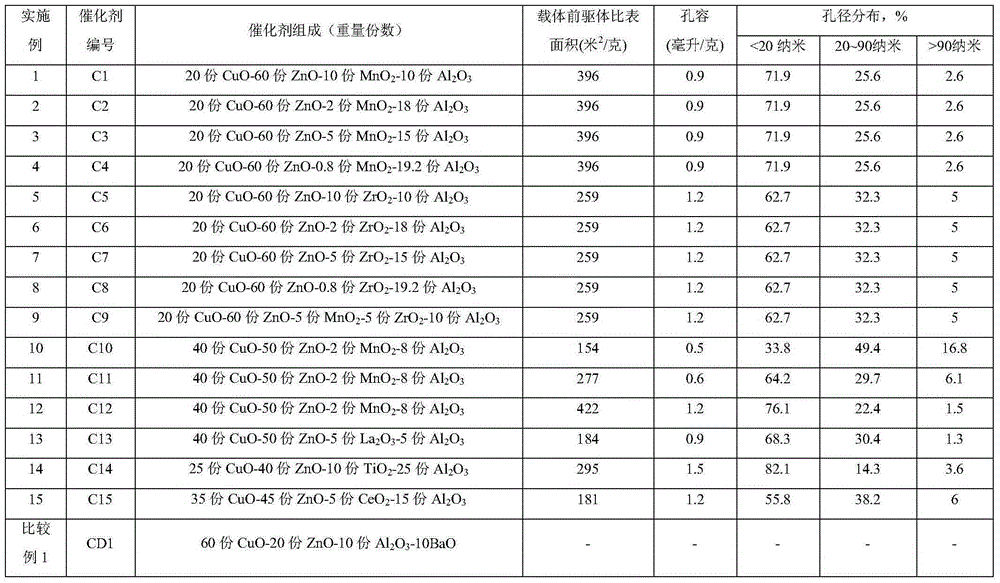Catalyst and method for preparing 1, 6-hexanediol by hydrogenation of dialkyl 1, 6-adipate
A technology of dialkyl adipate and hexanediol, which is applied in the field of catalytic chemistry and can solve problems such as high hydrogen/ester molar ratio, limitations of preparation methods, and high reaction pressure
- Summary
- Abstract
- Description
- Claims
- Application Information
AI Technical Summary
Problems solved by technology
Method used
Image
Examples
Embodiment 1
[0027] Weigh 73.6 grams of aluminum nitrate nonahydrate, prepare a solution with a concentration of 0.6M, stir evenly, transfer to a three-necked flask, and heat to 65°C. The aluminum nitrate solution was neutralized with 25% ammonia water, the pH value of the end point was controlled to be 8.6, the obtained gel was aged for 4 hours, filtered with suction, washed, dried at 90° C. and then used for later use.
[0028] Weigh 60.4 grams of copper nitrate trihydrate, 220.4 grams of zinc nitrate hexahydrate, and 41.1 grams of 50% manganese nitrate solution, and prepare a solution with a concentration of 0.6M, which is solution I; weigh 129.1 grams of sodium carbonate, and prepare a solution with a concentration of 1.0 The solution of M is solution II. Place the prepared alumina precursor in the bottom liquid, heat it to 75°C, add solution I and solution II dropwise in parallel, control the end point pH value at about 7.0, age the obtained slurry for 3 hours, filter, wash, and heat ...
Embodiment 2
[0030]Weigh 132.4 grams of aluminum nitrate nonahydrate, prepare a solution with a concentration of 0.6M, stir evenly, transfer to a three-necked flask, and heat to 65°C. The aluminum nitrate solution was neutralized with 25% ammonia water, the pH value of the end point was controlled to be 8.6, the obtained gel was aged for 4 hours, filtered with suction, washed, dried at 90° C. and then used for later use.
[0031] Weigh 60.4 grams of copper nitrate trihydrate, 220.4 grams of zinc nitrate hexahydrate, and 8.2 grams of 50% manganese nitrate solution, and prepare a solution with a concentration of 0.6M, which is solution I; weigh 118.4 grams of sodium carbonate, and prepare a solution with a concentration of 1.0 The solution of M is solution II. Put the prepared alumina precursor in the bottom liquid, heat it to 75°C, add solution I and solution II dropwise in parallel, control the end point pH value at about 7.0, and age the obtained slurry for 3 hours, filter, wash, and heat...
Embodiment 3
[0033] Weigh 110.3 grams of aluminum nitrate nonahydrate, prepare a solution with a concentration of 0.6M, stir evenly, transfer to a three-necked flask, and heat to 65°C. The aluminum nitrate solution was neutralized with 25% ammonia water, the pH value of the end point was controlled to be 8.6, the obtained gel was aged for 4 hours, filtered with suction, washed, dried at 90° C. and then used for later use.
[0034] Weigh 60.4 grams of copper nitrate trihydrate, 220.4 grams of zinc nitrate hexahydrate, and 20.6 grams of 50% manganese nitrate solution, and prepare a solution with a concentration of 0.6M, which is solution I; weigh 122.4 grams of sodium carbonate, and prepare a solution with a concentration of 1.0 The solution of M is solution II. Put the prepared alumina precursor in the bottom liquid, heat it to 75°C, add solution I and solution II dropwise in parallel, control the end point pH value at about 7.0, and age the obtained slurry for 3 hours, filter, wash, and he...
PUM
 Login to View More
Login to View More Abstract
Description
Claims
Application Information
 Login to View More
Login to View More - R&D
- Intellectual Property
- Life Sciences
- Materials
- Tech Scout
- Unparalleled Data Quality
- Higher Quality Content
- 60% Fewer Hallucinations
Browse by: Latest US Patents, China's latest patents, Technical Efficacy Thesaurus, Application Domain, Technology Topic, Popular Technical Reports.
© 2025 PatSnap. All rights reserved.Legal|Privacy policy|Modern Slavery Act Transparency Statement|Sitemap|About US| Contact US: help@patsnap.com



